Life Within Life
By John Palka — Posted February 6, 2021
We have been on many a walk together—in forests, on beaches, on the prairie. But let’s go out again, for there is still much to see and much to learn about life on the extraordinary planet that is our home. Today, let’s look for lichens!
Before we delve more deeply into what lichens actually are, let’s train our eyes simply to see them. To begin, let’s examine this scene from the magnificent old-growth forest of the Olympic Peninsula, where trees can be a thousand years old.
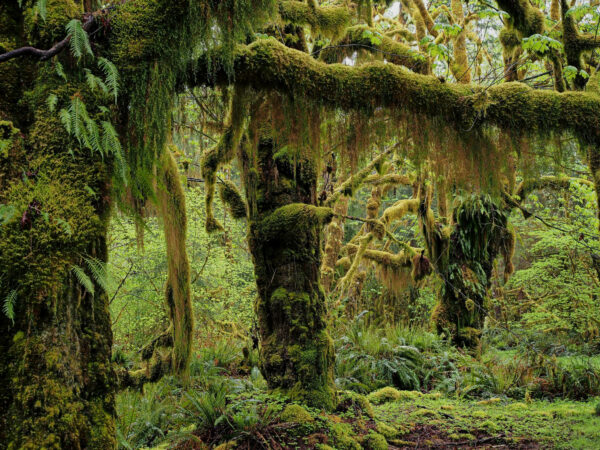
Massive trees, their trunks covered with mosses and ferns. Branches carpeted with mosses. And hanging down from the branches, like rich locks of hair, lichens—Old man’s beard, or Methuselah’s beard, Usnea longissima.

Just a part of the scene, a quiet component of the whole ecosystem. But—as we shall soon see—the lichens are unlike any other component.
Let’s look elsewhere. At an elevation of 6,000 feet, more or less at timberline, Hart’s Pass is one of the beauty spots of the North Cascades. The pass is reachable by a twisty gravel road, originally blasted into the cliffside to provide access to mines developed in the 1890s. The road’s terminus is now the take-off point for numerous hikes and there is a small camping area nearby.
Look closely. In the meadows there are lots of alpine flowers, as well as grasses and sedges. And on the rocks? Lichens.
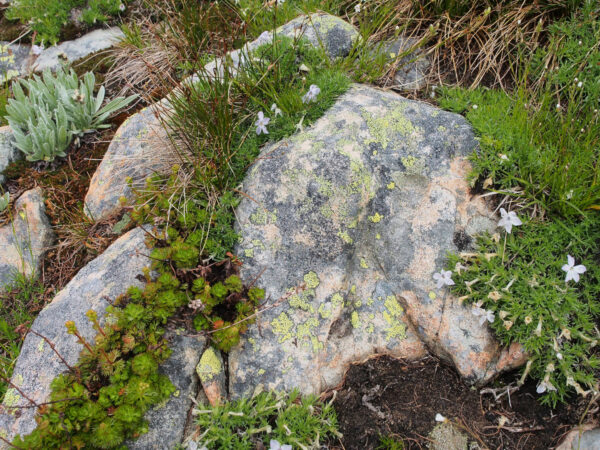
In the photo above we can see that virtually the entire rock surface is covered with lichens—green, pink, grey, blackish. These don’t look the least bit like Methuselah’s beard, but they are lichens nevertheless.
And for a glimpse of yet another kind of lichen, we can go back to the Olympic Peninsula.
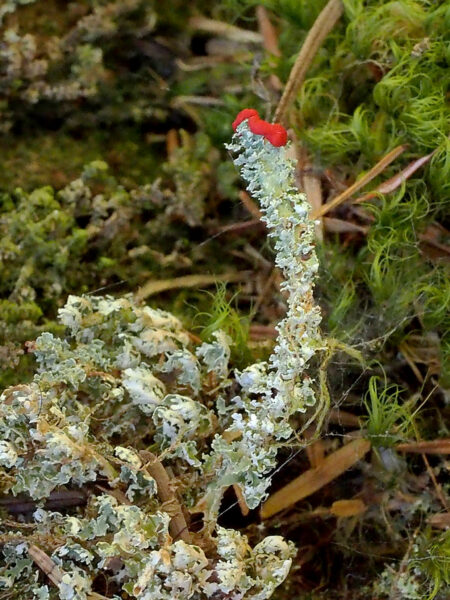
Standing upright in a layer of mosses covering the trunk of a fallen tree is a British soldier, Cladonia bellidiflora. Not like the strands of Methuselah’s beard, not like the wafer-thin colonies encrusting the rocks at Hart’s Pass, but a lichen nevertheless.
So, what is a lichen?
LICHENS ARE COMPOSITE ORGANISMS
A lichen always includes at least two distinct components, belonging to two different kingdoms of life. One is always a fungus, resembling, to some extent, a mushroom. The other is either an alga or a specific type of bacterium called a cyanobacterium (formerly called a blue-green alga). Both of these types of organisms are, unlike a fungus, photosynthetic, and that is crucial to the life of a lichen.
An association like this is called symbiotic—”together-living.” The fungal partner is called the mycobiont (myco = fungus, biont = living entity). The photosynthetic partner, whether an alga or a cyanobacterium, is called the photobiont (photo = light, biont = living entity).
In what sense do a fungus and a photobiont form a single organism?
In the great majority of cases, the fungus forms the body (thallus) of the lichen. The cells of an algal photobiont are most often arrayed in a layer within the thallus. The cells of a cyanobacterium are generally scattered and nestle among the threads (hyphae) of which the body of any fungus is composed.
The photobiont provides nutrition to the fungus in the form of sugars or other molecules that it generates via photosynthesis. It is believed that the mycobiont provides various forms of protection and support to the cells of the photobiont. Among these are mechanical protection, protection against intense light (which can be lethal), and a supply of water.
Being symbiotic allows lichens to occupy a far wider ecological range than do non-lichenized relatives of the two partners. For example, since a fungus is not photosynthetic, it has to obtain its nutrients from some other source. This might be the soil, a log, or a tree. No fungus could ever grow on a rock, however. Neither could an alga survive long on a dry rock. Yet, rocks in many environments, including very dry ones, are covered with lichens.
MAKING MORE LICHENS
Reproduction is a hallmark of life. If an organism does not reproduce, then its genetic heritage vanishes from the life system of the Earth.
There are two basic ways that organisms reproduce: asexually and sexually.
1. Asexual reproduction is, basically, a direct replication of the original organism. This can be accomplished in a variety of ways. One that occurs commonly in lichens is that cells of the existing lichen are segregated, protected with a coat of some sort, and then shed into the environment. If the shed particle lands in a favorable spot, it sprouts and develops into a whole new organism.
Since the cells that founded the new organism came from the body of the old one, the two are genetically identical. The only source of genetic variation in asexual reproduction is mutation.
2. Sexual reproduction is far more complex. The details of how it works in fungi are different from what we are used to in animals, and we will not go into this here.
What matters most is that in sexual reproduction, (a) reproductive cells from two different parents are brought together, and (b) those cells themselves contain a mix of genes contributed by the previous two parents. Mutations also occur. The result is that overall genetic variation from one generation to the next is far greater than in the case of asexual reproduction.
Generally, we can say that the big advantages of asexual reproduction are speed and the fact that there is no need for partners to come together. The limitation is that variation stems only from mutation. The advantage of sexual reproduction is the significant increase in variation. This is important because variation is a prerequisite for evolution by natural selection. The major limitation is the need for partners to be brought together when both are fertile.
And lichens? They do both! Let’s look at some examples.
Alder trees are famous for being favorites for colonization by lichens. Every patch of bark on the red alders in this cluster (Alnus rubra, Family Betulaceae) on Whidbey Island in Puget Sound is covered by a lichen except for the areas that are moss-covered.
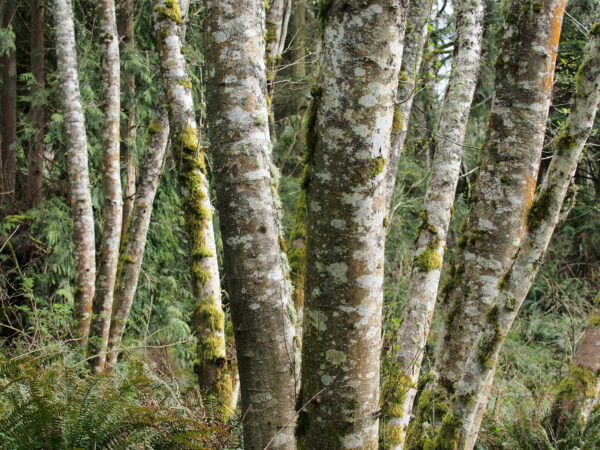
When you look more closely, you see a variety of specialized structures on the surface of the lichen colonies. All of these have to do with reproduction. In the picture below, the little buttons on the upper colony (probably of Ochre disk crust, Ochrolechia laevigata) and the elegant black lines in the lower colony (Pencil script, Graphis scripta) are the sexual reproductive structures of those species. Within them are produced and stored multitudes of sexually generated spores ready to be released into the environment.

Once the spores are shed, however, and ready to start a new organism, a problem manifests. The spores were produced exclusively by the mycobiont. Even if they land in favorable surroundings, where will the necessary photobionts come from? There needs to be an encounter with a new photobiont, and this is a risky proposition.
The problem is solved by the asexual reproduction that lichens also employ. The particles they shed in asexual reproduction are already composites. Within each such particle is a length of hypha of the original fungus wrapped around one or a cluster of cells of the photobiont. When the particle lands and is ready to produce a new lichen, both the mycobiont and the photobiont are present.
Here is an example of structures that mediate asexual reproduction, seen in the so-called Exploding tip lichen (Hypogymnia physodes).
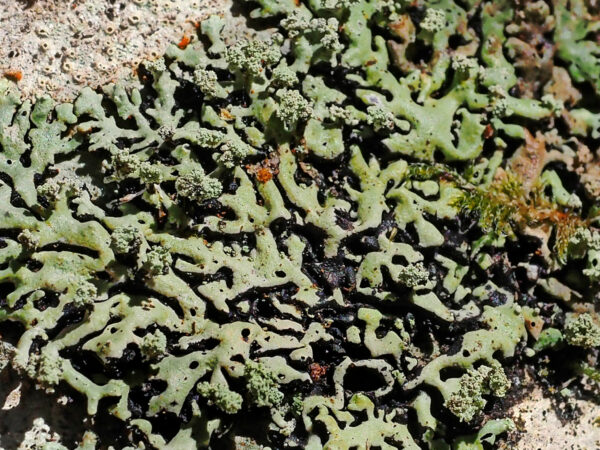
In the upper left-hand corner of the picture are the sexual structures of another lichen. The asexual structures of Hypogymnia are the green clusters of tiny globules. The photograph below shows these at a higher magnification. Each globule contains both a sample of the mycobiont and a sample of the photobiont.
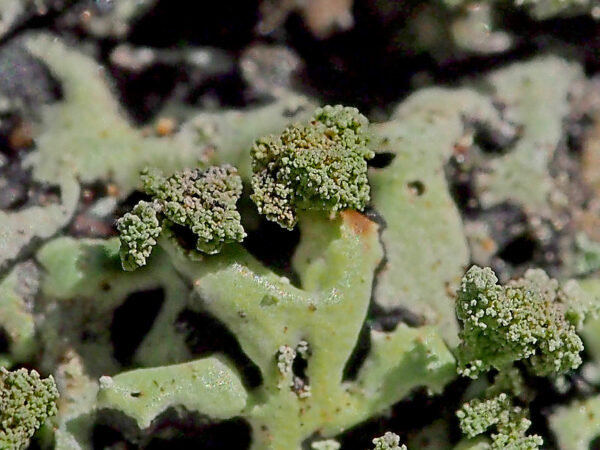
Lichens carry out asexual reproduction in other ways as well. Some, like Methuselah’s beard, simply break off fragments which always contain both the mycobiont and the photobiont. No sexual structures have been observed in Methuselah’s beard and even specialized asexual structures are rare or lacking. Other lichens produce asexual reproductive structures containing reproductive particles that are so tiny they can barely be seen without magnification. These particles are not apparent in my photographs. In all cases, however—whether fragments or particles—they contain cells of both the mycobiont and the photobiont, so they are ready to give rise to both components of the new lichen.
SPREADING FAR AND WIDE
Knowing how lichens can disperse into the environment, let’s refocus on the environmental extremes in which they can thrive. First, consider rocks in harsh environments, where neither fungi alone nor, in most cases, algae alone would survive.
We already saw rocks at Hart’s Pass. Here are some rocks in the Icicle Creek area on the eastern side of the Cascade Mountains, where the winters are really harsh.
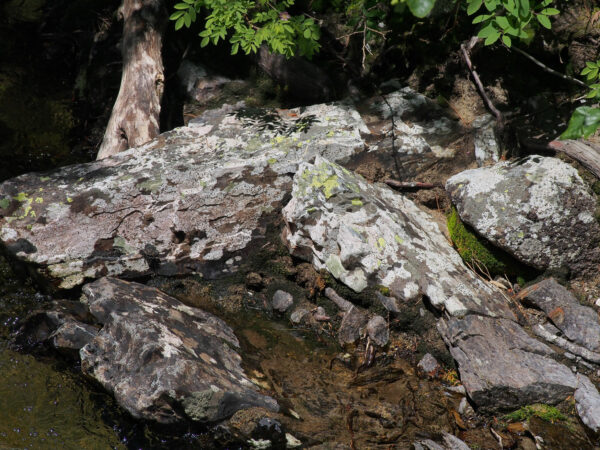
These rocks are as thoroughly colonized as the alders in the much milder Puget Sound area. Below is another example, this time far away from water. Hardly any bare rock remains. The black spots are sexual reproductive structures.
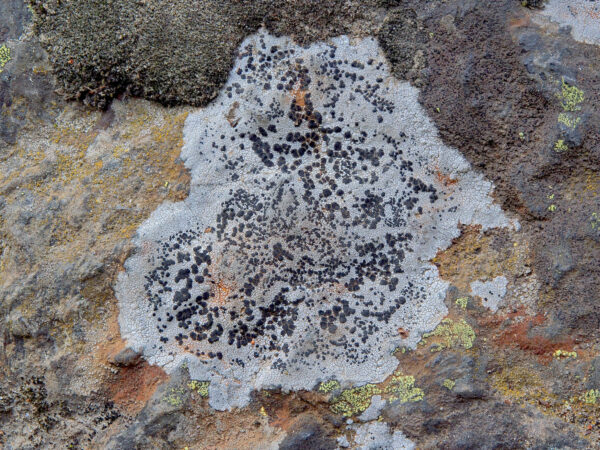
Below is perhaps the other extreme, the rain forest where we started our adventure. This lichen is famous—Fairy barf (Icmadophila ericetorum). It grows on bark but really likes the mosses that have colonized the bark. The pink structures serve sexual reproduction. Fairy barf has been very, very successful—the species occurs widely in both North America and Europe.
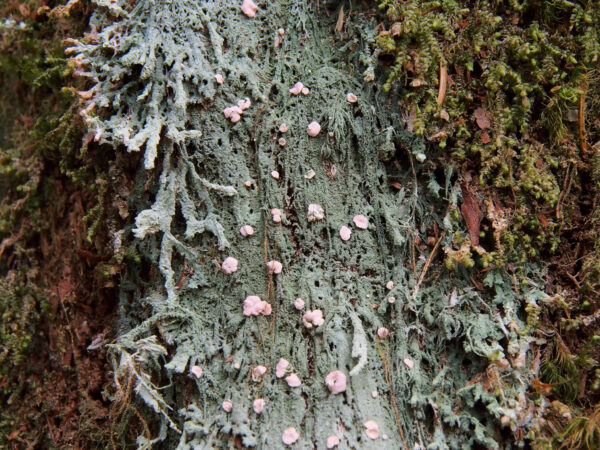
And finally, pictured below is a common leaf-shaped (foliose) lichen, Frog pelt (Peltigera neopolydactyla). The yellow structures house asexual globules. On the underside of each thallus you see what look like roots. These are structures for attaching the lichen to the substrate and they are highly prominent in this species.
CLIMATE EXTREMES
We have already seen lichens in a variety of habitats. They do amazingly well in the bitter cold. Below is an array of species growing on the bark of a tree in the cold Minnesota winter. On the day I took this picture, it was below 10 degrees Fahrenheit, and soon it dropped to below zero. Temperatures like this, coming frequently during the winter, have no impact on the lichens other than to slow down or stop their growth, but only temporarily.
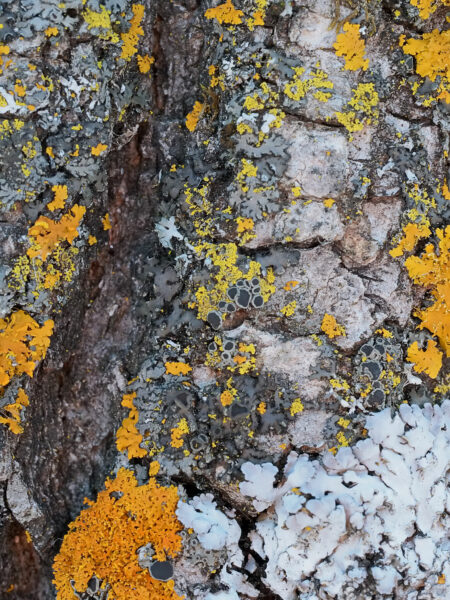
If the environment turns dry, the metabolism of lichens, again, slows down. However, life processes are sustained. Let me give you a personal example. One summer while we were still undergraduates at Swarthmore College, my beloved Yvonne and I went out west. She conducted behavioral studies on marmots at the Rocky Mountain Biological Laboratories in Colorado. I served as the field assistant in a botany course at the University of Washington that traveled to one mountain range after another in the Southwest. Once both programs were finished, I came to spend time with Yvonne in the Rockies. We backpacked on high trails, and on one of our trips we found the rock you see below, studded with magnificent quartz crystals and hosting a whole garden of brightly colored lichens. I put it, and several other equally beautiful and much heavier rocks, in my backpack and carried the whole load until we returned to the cabin in which we were staying. It was part of our courtship!
Over sixty years later, we still have those rocks. And the lichens that were so brilliant back then? As you can see, most of them are still brilliant today, despite not having had a single drop of water in all those sixty years!
WHAT ARE ALL THE COLORS?
Lichens produce a large number of chemicals that fall into the category of “secondary metabolites,” meaning that they do not participate directly in the maintenance of the living state, in growth, or in reproduction. Most of the 700 or so secondary metabolites that have been found in lichens are unique to them—they do not occur in other organisms. They are produced primarily by the mycobionts, but they do not occur in the non-lichenized relatives of those mycobionts. A number of them are colored.
This vast array of secondary metabolites plays a diversity of roles. Some appear to be antibiotic, to protect against familiar and dangerous bacteria like Staphylococcus and Bacillus, and are thought to contribute to the enormous ages of some lichens—in the hundreds and even thousands of years! Some screen out UV, thus protecting the photosynthetic machinery of the photobionts and enabling lichens to thrive at high elevations where we humans are well advised to apply sunscreens. Some play an important role in the absorption and internal distribution of water, a crucial matter in dry environments. I have not yet seen any evidence that the color of lichens plays a biological role in the way the color of flowers, for example, does.
AND THERE’S MORE
Ever since the nineteenth century, lichens have been understood to be symbiotic systems such as I have described here—comprised of a mycobiont and a photobiont, with the photobiont being either an alga (around 85 percent), a cyanobacterium (around 10 percent), or rarely both. Recently, however, the story has grown much more complex.
Multiple photobionts, multiple forms. The body of a lichen is basically the body of its fungus. The photobiont, however, has an influence on the form of that body. Exactly what form a whole lichen assumes depends on what kind of photobiont is present in it. If it is an alga, it assumes one form; if it is a cyanobacterium, it takes a different form. The forms can be so different that biologists have placed them into separate species before they discovered that the fungus, on which the scientific name is based, was exactly the same. If an alga and a cyanobacterium occupy different portions of a single lichen, those portions can assume different forms. And if the fungus is grown by itself in the lab, with no photobiont, it assumes still another, and very different, form.
As of 2018, we know that sometimes structural differences exist even if both alternative photobionts are algae—the symbiosis of a single species of fungus with different species of algae leads to different forms of the whole lichen. How any of these differences come about is not yet understood.
Multiple fungi. For a hundred and fifty years we believed that a lichen is composed of one species of fungus and one species of either an alga or a cyanobacterium or, rarely, both. That is no longer true. In 2016 we learned that it is common for there to be two fungi in a single lichen, not only the mycobiont we have known about for so long but also a yeast that had previously gone undetected. The yeast cells are usually concentrated in the outer layers of the lichen. So, now we realize that many and perhaps most lichens are the symbiosis of not two but three different, genetically distinct, organisms—two fungi and a photobiont.
And bacteria too. And there’s still more. It has been known for a long time that many bacteria, and also archaea (which look like bacteria but are different enough to warrant having a kingdom unto themselves), are associated with lichens, but it was assumed that this was simply surface contamination. Any living organism will have such microorganisms on its surface unless it is sterilized. Now, however, there is compelling evidence that there are also bacteria and archaea that form a functional component of the lichen and contribute to its metabolism. Conceptually, this is rather like the microbiome that has gained so much attention in human biology, and indeed this microbial population is often referred to as the “lichen-associated microbiome.”
LICHENS AND PLANET EARTH
Lichens, these amazingly complex, multi-kingdom symbiotic communities, are far more significant components of the entire system of life on planet Earth than we usually realize.
In the Earth’s history, lichens were among the first organisms to colonize dry land. They could do this because their photobionts provided them with the necessary metabolic energy—they did not depend on feeding on other organisms. The chemicals they secreted contributed to the weathering of the rocks which they encrusted and thereby contributed to the building up of the soil on which plants could grow. In this way, lichens played an important role in the evolution of the life on land that we are so familiar with.
They continue to be important in modern times. Because lichens do not depend on any other organisms for food, because they are so tolerant of the extremes of temperature, and because they survive amazingly well under extremely dry conditions, they occur in a vast range of ecosystems. Indeed, it has been estimated that lichens are the dominant larger organisms over approximately ten percent of the Earth’s land area. They continue to colonize rocks and exposed soil surfaces, they fertilize and protect soils against erosion, they provide nitrogen compounds to the ecosystems in which they live, they even contribute significantly to the removal of carbon dioxide from the Earth’s atmosphere.
We are members of a planetary network of life that is incredibly complex, thoroughly intertwined with the planet’s non-living components, and full of life-sustaining interactions. We have long appreciated that this is true at the ecosystem level. We are now discovering how true it also is at the level of single organisms—that in fact “single” is rarely the correct adjective. Lichens are a dramatic example of this truth. Watch for them as you walk, relish their beauty, and let them remind you of the adage “We are all in this together.”
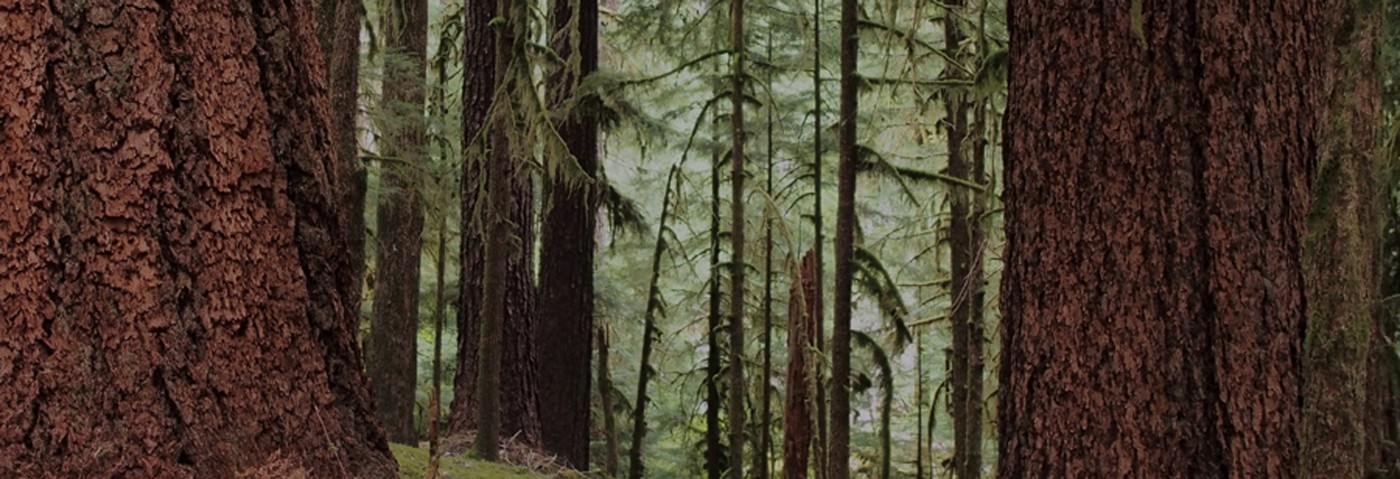
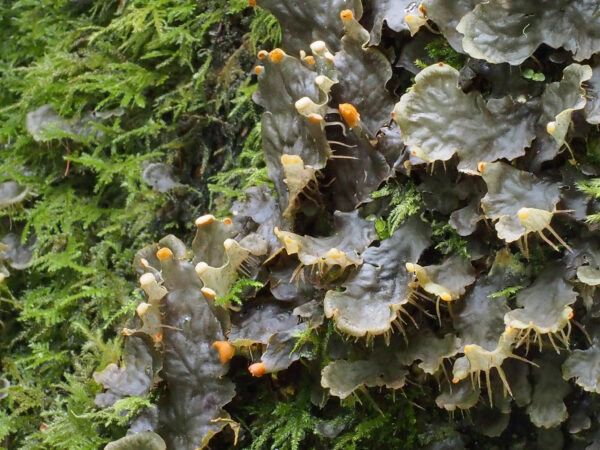
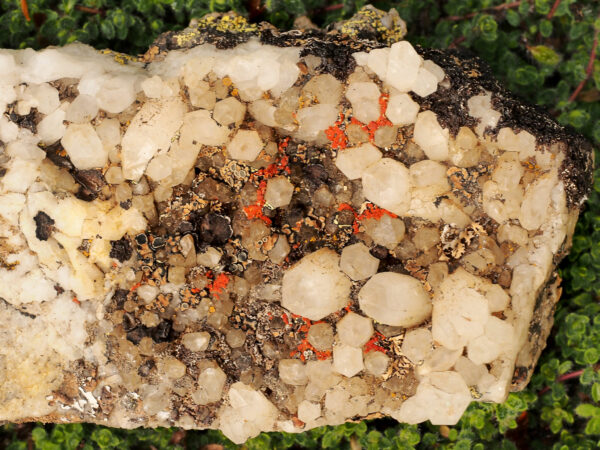
Johnny, this is wonderful. I have a friend named Pat who will pore over your blog post until she knows it by heart, so I’m going to post it on Facebook and make sure she knows it’s there.
That’s super, Kit! Thanks for letting me know.
This one, especially about lichens brought back memories back to my teaching days in 70’s in Castlegar, BC, Canada. My neighbour and colleague was Dennis Holden, who was teaching forestry. His masters degree was on lichens and if I remember right he did his field work in Wales. He was a UBC graduate. He told me exactly what you had mentioned in this hlog about how lichens helped create soul!
It’s been great to discover unexpected lichen lovers! Lichens and soul? Does that mean a sense of wonder and unity?
Hah! I’ve spent the last 2 years writing 7 papers on the ultrastructure of lichens — what can be seen with electron microscopes — and they’re fully as wonderful all the way down to their membranes and proteins as they are just looking at them in the forest. I’ll be giving a zoom talk on this work for non-professionals on Feb. 10; if you’d like to join us, please send me an email at [email protected] and I’ll send you the zoom link.
I knew you had an interest in lichens, Ursula, but I did not realize that you have actually been working on them. I’ll be e-mailing you; perhaps you could send me some PDFs as well as the link. I hope you didn’t spot any errors!
I first got interested in lichens when I took a class in vegetal dying in St. Jean du Gard in
southern France. There we gathered a couple of different finds of lichen and used them to dye wool. A few years later I gathered other lichens on my father’s ranch land in Texas and dyed fleece with them. Then I bartered my massages to have the fleece carded and spun and woven into a tryptic wall hanging which hung in my parents’ living room for years and now in mine. The colors are warm earthen tones. Thanks for this post. It deepened my knowledge of lichens and brought back some wonderful memories.
Wow, Jan, what a narrative! I’m sure that other readers will find it special as well.
Another amazing journey with Johnny..!! Lichen have always fascinated me — the way they grow everywhere on everything and seemingly on nothing. Thanks for the joyful education— as usual!
Thank you, Marty. And also as usual, I learned a whole, whole lot while preparing it!
For one who has lived in urban settings and in a tropical climate, lichens are not familiar. This blog was a fantastic read for me not only on that account but something fundamentally more eye-opening. For the first time I could get the full impact of the scientists’ perception of the reality around us so as to reach the Final Truth as in a problem of integral calculus. The mystical expansion of consciousness to include everything within one’s awareness, the Hindu Yogi’s effort, isolates itself from external realities as distractive. This article opened my eyes to the unalterable fact that whichever way you go, the destination is the same; something that Columbus set out to test. Thank you, Professor.
It is a great honor to read your words, RSV. Thank you.
Thank you Johnny. I so appreciate your clear and beautiful explanations and your invitation into very current research and perspectives on lichens. I followed some of the links you included (which of course lead to other links) and enjoyed my adventures. Over years of being involved with teaching biology it has been so interesting to watch as researchers discover more about various symbioses. And interesting to think about how this affects how we understand concepts/terms like organism, individual, community, ecosystem. One concept that seems to me to be so inherent to life is interdependence. As you note, let lichens remind you “We are all in this together.”
Thank you, Karen. It certainly does seem like interdependence, at multiple levels, is becoming more and more prominent in our understanding of living systems. On the largest scale, there’s the Gaia Hypothesis (we looked at it in “Is Earth Alive?” March 5, 2017)? James Lovelock and Lynn Margulis sure had a lot of insight! So did David Grinspoon, whom I quoted at the end: When we stop thinking of planets as merely objects or places where living beings may or may not be present, but rather as themselves living or nonliving entities, it can color the way we think. Perhaps life is something that happens not on a planet but to a planet: it is something that a planet becomes.
WOW. I am humbled by the reality of what for me, until now, has only been a source of curiosity, amazement and beauty along with some intellectual understanding of symbiosis. Now I can have a spiritual experience of lichens, illuminated not only by you but by the comments here! As is the case with all good poetry and prose, there are levels and levels of meaning and insight for those only willing to look. THANK YOU!
Marc, You are bringing tears to my eyes!
In the late 1990’s we used lichens to establish where a pollution source was contributing to acid rain in our high mountain lakes. That was my real introduction to the fascinating world of lichens. Those “insignificant” lichens proved the source of pollution (a coal powered plant) and forced changes in their emissions. It was amazing research! Loved your information here!!
That’s a great example, Karen! As you doubtless know, lichens have been widely used as pollution monitors, sometimes even by government agencies. I do not know why they are so resistant to extreme temperatures and to drought but so sensitive to chemical pollutants. Thanks for writing!